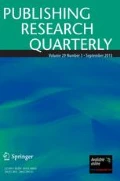Abstract
Publication following thorough peer review has been one the essential drivers of scientific progress. While the emergence of open access journals has spread knowledge to a wider audience, a few publishers have started to exploit the model of being specifically paid by authors. They have published so-called predatory journals that have sacrificed scientific scrutiny in favor of revenue. Papers in such journals may bear illegitimate conclusions and thus hamper scientific progress. Here, we did not only explain predatory journals in general, we also elaborated on an example and thereby demonstrated how exactly these journals may deviate from scientific standards. Namely, a manufacturer of bacterial endotoxin tests published in a potentially predatory journal and neglected relevant literature, ill-referenced other papers and made use of judgmental, non-scientific language. Apparently, said manufacturer aimed to shed doubt in recombinant DNA technology (here recombinant Factor C) for bacterial endotoxin testing and, thus, restrict its competitors’ access to this market. In turn, this may prevent the development of more accurate, reliable, rapid and affordable bacterial endotoxin tests und in turn hamper progress in pharmaceutical development and manufacturing.


Similar content being viewed by others
References
Ross JS, Gross CP, Krumholz HM. Promoting transparency in pharmaceutical industry-sponsored research. Am J Public Health. 2012;102(1):72–80.
Battisti WP, Wager E, Baltzer L, Bridges D, Cairns A, Carswell CI, Citrome L, Gurr JA, Mooney LA, Moore BJ, Peña T, Sanes-Miller CH, Veitch K, Woolley KL, Yarker YE. International society for medical publication professionals good publication practice for communicating company-sponsored medical research: GPP3. Ann Intern Med. 2015;163(6):461–4.
Shimasaki C.D. (2009) Start with the Idea: Licensing and Protecting Core Assets. In: The Business of Bioscience. Springer, New York, NY. https://doi.org/10.1007/978-1-4419-0064-7_3
https://tressacademic.com/identify-predatory-journals/ (retrieved 19/03/2021)
https://doaj.org/ (retrieved 19/03/2021)
Grudniewicz A, Moher D, Cobey KD, Bryson GL, Cukier S, Allen K, et al. Predatory journals: no definition, no defence. Nature.
Oberhaus, D. 2018. Hundreds of Researchers From Harvard, Yale and Stanford Were Published in Fake Academic Journals. https://oralcancernews.org/wp/hundreds-of-researchers-from-harvard-yale-and-stanford-were-published-in-fake-academic-journals/ (retrieved 19/03/2021)
Beall J. Medical publishing and the threat of predatory journals. Int J Womens Dermatol. 2016;2(4):115–6.
Schauss, A.G. Published Studies Give Dietary Supplements Credibility, but Watch Out for Bad Journals. October 16, 2014. https://www.nutritionaloutlook.com/view/published-studies-give-dietary-supplements-credibility-watch-out-bad-journals (retrieved 19/03/2021)
Severin A, Low N. Readers beware! Predatory journals are infiltrating citation databases. Int J Public Health. 2019;64(8):1123–4. https://doi.org/10.1007/s00038-019-01284-3.
Shibata T, Kobayashi Y, Ikeda Y, Kawabata SI. Intermolecular autocatalytic activation of serine protease zymogen factor C through an active transition state responding to lipopolysaccharide. J Biol Chem. 2018;293:11589–99.
http://www.journalijdr.com/innovative-mechanism-limulus-amebocyte-lysate-activation-achieve-specificity-and-sensitivity (retrieved 19/03/2021)
https://beallslist.net/standalone-journals/ (retrieved 19/03/2021)
https://predatoryjournals.com/journals/ (retrieved 19/03/2021)
Nakamura T, Morita T, Iwanaga S. Lipopolysaccharide-sensitive serine-protease zymogen (factor C) found in Limulus hemocytes isolation and characterization. Eur J Biochem. 1986;154(3):511–21. https://doi.org/10.1111/j.1432-1033.1986.tb09427.x.
Kikuchi Y, Haishima Y, Fukui C, Murai T, Nakagawa Y, Ebisawa A, et al. Collaborative study on the bacterial endotoxins test using recombinant factor C-based procedure for detection of lipopolysaccharides. PMDRS. 2017;48:252–60.
Reid, N. 2020. The Criticality of Detecting Relevant Endotoxins in Global Pharmaceutical Water Samples. PharmaLab Congress 2020. talk given on 2020–11–10.
Tsuchiya, M. 2014. Possible Mechanism of Low Endotoxin Recovery. American Pharmaceutical Review 17(7).
Tan NS, Ho B, Ding JL. High-affinity LPS binding domain(s) in recombinant factor C of a horseshoe crab neutralizes LPS-induced lethality. FASEB J. 2000;14:859–70.
Tan NS, Ng MLP, Yau YH, Chong PKW, Ho B, Ding JL. Definition of endotoxin binding sites in horseshoe crab Factor C recombinant sushi proteins and neutralization of endotoxin by sushi peptides”. FASEB J. 2000;14:1801–13.
Wang C, Nelson T, Chen D, Ellis JC, Abbott NL. Understanding lipopolysaccharide aggregation and its influence on activation of Factor C. J Colloid Interface Sci. 2019;552:540–53.
Kobayashi Y, Takahashi T, Shibata T, Ikeda S, Koshiba T, Mizumura H, Oda T, Kawabata S. Factor B Is the Second Lipopolysaccharide-binding Protease Zymogen in the Horseshoe Crab Coagulation Cascade. J Biol Chem. 2015;290:19379–86.
Yamashita K, Shibata T, Takahashi T, Kobayashi Y, Kawabata SI. Roles of the clip domains of two protease zymogens in the coagulation cascade in horseshoe crabs. J Biol Chem. 2020;295:8857–66.
Nakamura T, Horiuchi T, Morita T, Iwanaga S. Purification and properties of intracellular clotting factor, factor B, from horseshoe crab (Tachypleus tridentatus) hemocytes. J Biochem. 1986;99:847–57.
Wang L, Ho B, Ding JL. Transcriptional regulation of limulus factor C: repression of an NFkappaB motif modulates its responsiveness to bacterial lipopolysaccharide. J Biol Chem. 2003;278(49):49428–37.
https://thinkchecksubmit.org/ (retrieved 19/03/2021)
Author information
Authors and Affiliations
Corresponding author
Ethics declarations
Conflict of interest
Brendan Tindall and Thomas Uhlig are employees of bioMerieux.
Additional information
Publisher's Note
Springer Nature remains neutral with regard to jurisdictional claims in published maps and institutional affiliations.
Rights and permissions
About this article
Cite this article
Tindall, B., Uhlig, T. & Perdomo-Morales, R. The Important Distinction Between Peer-Reviewed and Predatory Journals: A Bacterial Endotoxin Test Case. Pub Res Q 37, 399–406 (2021). https://doi.org/10.1007/s12109-021-09818-5
Accepted:
Published:
Issue Date:
DOI: https://doi.org/10.1007/s12109-021-09818-5



